Epsilon Euskadi ee1 Drives Titanium Upright Design
The critical safety demands of Le Mans Series race-car design requires high-precision investment casting in titanium alloy, with patterns made with rapid prototyping for creating titanium uprights.
Latest News
October 23, 2008
By Susan Smith
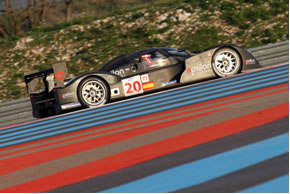 Mario Romancini driving for Epsilon Euskadi at the Silverstone round of the 2008 World Series by Renault season. |
In motor sport racing, the aim of design is to produce a vehicle with parts that withstand high speeds and the grueling stress of the track over long distances.
For many years, plans for a Spanish-built Le Mans racer circulated among the racing world. Not until the Epsilon Euskadi racing team, based in Askoitia, Spain, did that become a reality.
Juan Villadelprat, a former McLaren, Ferrari and Benetton mechanic/manager, ran the Epsilon Euskadi in various one-make racing series. The Epsilon Euskadi achieved notoriety again in 2005 when Polish driver Robert Kubica won the World Series by Renault with the car, vaulting him to Formula 1 fame. Villadelprat hired former Lola designer John Travis to ensure that his cars were successful. What Travis came up with was a very smooth, fixed-head prototype racer, which complied with the current LMP1 regulations. When Travis moved to Ferrari, Sergio Rinland, with notable F1 experience under his belt, took his place as chief engineer.
The Epsilon Euskadi team participated in the 2008 Le Mans 24 Hours with their new car, Epsilon Euskadi ee1, a first-time Le Mans entry for the Spanish team.
Epsilon Euskadi began work on their ee1 project in 2004. The Epsilon Euskadi ee1, powered by the Judd v10 engine, took its first spin on the track at the end of February 2008. There are differences in the way the Epsilon Euskadi is designed: it is a closed cockpit car with the new Judd v10 engine used without a subframe in order to lower the center of gravity as much as possible. It also uses a semi-composite Pankl transverse semi automatic gearbox. The goal was to keep the height down, with high fenders contrasting with a low nose and side pods. A shrouded front suspension resembles the Audi aerodynamic design, which should make it easy to drive on long-distance endurance races.
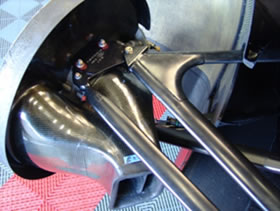 | 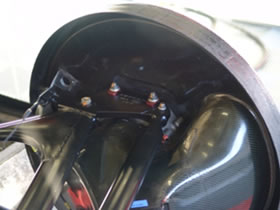 |
| Uprights on the car. The criticality of the piece is due to the notable quantity of stress that is subjected to. | |
Enter CRP
The collaboration between Epsilon Euskadi and CRP Technology began at the end of 2007 with the aim of optimizing some crucial safety features of the new Epsilon Euskadi ee1 for the Le Mans Series and the 2008 Le Mans 24 Hours: front and rear uprights cast in titanium using the CRP Rapid Casting method.
CRP Technology s.r.l. has contributed to the success of many racing teams in F1, Moto GP, Rally Raid, ALMS and the World Rally Championship. The company is involved in the process of manufacture from the initial stages of design and development through the first prototype and into the final construction phase.
CRP was brought onboard to develop one of the key components of the suspension system, as well as titanium uprights, a core business for CRP. CRP’s technicians engineered Epsilon uprights with the use of high-precision investment casting, in titanium alloy, with patterns made in rapid prototyping.
The upright, a critical and supporting part of the suspension core, is the connection between the wheel group (tire, rim, brake disc, hub), on one side, and the suspension unit (lower and upper wishbone, pushrod arm, steering arm or toe-in arm), on the other. The brake calliper is also connected to it.
What makes this part so critical is that it is an unsuspended mass that is subject to significant stress, owing to speeds reached by the vehicle, or derived from braking and shifting of the suspensions, which generates continuous load transfer.
When all these stresses occur simultaneously, a considerable amount of stress is put on the vehicle, particularly when braking hard with the wheels fully turned and on rugged road surfaces. Should the upright break, the wheel could become dysfunctional. The requirements for the upright are consequently critical — the need for additional rigidity (to limit buckling as much as possible), the lowest possible weight, and maximum reliability and quality (translating to safety).
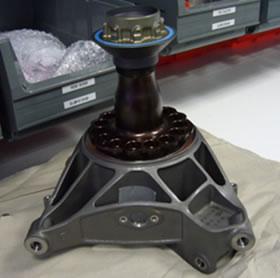 | 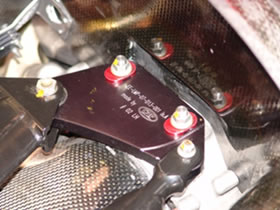 Epsilon Euskadi titanium casting uprights |
Material of Choice
Titanium was chosen as the material of choice for the Epsilon uprights due to mechanical properties of the material and the density (specific weight) of this alloy compared to steel. Rinland said that they could have used machined aluminum, steel fabricated of MMC, but titanium provided the best compromise cost-rigidity-weight-strength-durability. “And for our Titanium Uprights, we expect the whole season and more, that is 15,000 to 20,000Km.”
Usually uprights are built using a combination of two technologies, where some single components are machined from a solid, and then those components are welded to each other. This process has limitations in that the final upright has difficulty reacting to mechanical stress. The method generally uses parts obtained from semi-processed pieces, which has a molecular structure that works very well in one direction but not in others (anisotropic). Rapid casting, on the other hand, is isotropic, meaning that it reacts in a similar way no matter what structural direction it travels. Titanium rapid casting offers greater flexibility during the design stage and obviously is more effective for structural behavior, plus it is more cost effective.
What CRP uses for the upright is one of its latest developments, Windform PS, the new polystyrene for disposable models. Windform PS is suitable for producing complex investment casting patterns, with its improved surface quality and details reproduction, less “curling” effect on the first layers, very low ash content, which makes it suitable for highly reactive alloys such as titanium alloys and others.
Epsilon Euskadi provided CRP with an initial study of the upright project in October 2007. CRP’s CAD department — in concert with the R&D department — made some engineering modifications to the design in order to optimize the design for the casting process to come and to improve final performance in terms of rigidity, reliability, and weight.
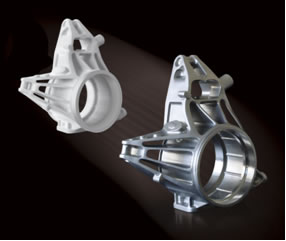 Upright disposable model made with Windform® PS and Titanium Upright. |
Adjustments & Analysis
To the front upright, CRP added a drawing of ribs that connect the two shoulders, which was done in order to stiffen the spool area. Another modification was a noticeable stiffening ring added to guarantee greater space during the turning process.
The rear uprights also bore the addition of ribs that connected the two shoulders to stiffen the spool area as well as the stiffening ring. The mass underneath the top mounting point was also decreased to keep from causing strain that compromises the quality of the cast. Also, the team created a more uniform thickness and increasing curvature to create a lower thermal center of gravity.
The mathematical model was then subjected to an FEM analysis to identify areas where improvements may be needed. Once those changes were incorporated into the model, CRP generated the disposable models using Windform PS within its RP department. The models were then sent to the foundry for the investment casting procedure. The rough castings underwent hot isostatic pressing treatment, thermal treatments, and dimensional control and setup for mechanical machining utilizing 3D laser scanning. Finally they were CNC-machined.
Designing a Le Mans car is one of the really creative and innovative opportunities for a designer, according to industry professionals. Epsilon Euskadi runs a Technical Specialisation Masters in Motor Racing Competition (M.E.T.C.A), in collaboration with the University of Mondragon (Onati,Spain). This postgraduate course gives students within Europe the opportunity to do practical work in top class competition in the world of motor racing. The qualifications they receive also prepare them for employment in the conventional automotive industry.
CRP Technology, s.r.l.
Modena, Italy
crptechnology.com
Susan Smith is a contributing editor for Desktop Engineering magazine. She has been an editor and writer for the technology industry for more than 15 years and resides in Santa Fe, NM. Send e-mail about this article to [email protected].
Subscribe to our FREE magazine, FREE email newsletters or both!
Latest News
About the Author
DE’s editors contribute news and new product announcements to Digital Engineering.
Press releases may be sent to them via [email protected].






